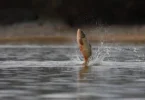Barracuda fish, with their sleek bodies and formidable presence, are among the most iconic predators of the ocean. From their physical characteristics to their role in marine ecosystems, these creatures captivate the imagination of marine enthusiasts worldwide.
1. Introduction to Barracuda Fish
Barracudas belong to the Sphyraenidae family and are renowned for their streamlined bodies, razor-sharp teeth, and impressive speed underwater. These fish are prevalent in tropical and subtropical oceans around the globe, inhabiting a diverse range of marine environments.

2. Physical Characteristics
Size and Appearance
Barracudas exhibit a diverse range of sizes, with some species reaching lengths of up to six feet. Their elongated bodies are covered in silvery scales, providing excellent camouflage in open water. Additionally, barracudas possess two dorsal fins, a large mouth filled with sharp teeth, and keen eyesight to spot prey from afar.
Distinctive Features
One of the most distinctive features of barracudas is their formidable jaws lined with rows of razor-sharp teeth. These teeth, combined with their lightning-fast swimming speeds, make barracudas efficient predators in the underwater realm.
3. Habitat and Distribution
Barracudas are predominantly found in tropical and subtropical waters worldwide, inhabiting coral reefs, seagrass beds, and offshore environments. They are often encountered near drop-offs and underwater structures where they can ambush unsuspecting prey.

4. Diet and Feeding Habits
As voracious carnivores, barracudas primarily prey on smaller fish, crustaceans, and squid. Using their exceptional speed and agility, they launch swift attacks on unsuspecting prey, often striking with remarkable precision.
5. Behavior and Predatory Nature
Barracudas are solitary hunters known for their ambush tactics and lightning-fast strikes. They often patrol the edges of reefs or cruise along drop-offs, waiting for the opportune moment to dart forward and seize their prey.
6. Reproduction and Lifecycle
During spawning season, female barracudas release their eggs into the water, where they are fertilized by the male. The larvae then drift with ocean currents until they mature into juvenile barracudas, eventually developing into formidable predators as they grow older.
7. Importance in Marine Ecosystems
Barracudas play a crucial role in maintaining the balance of marine ecosystems by controlling the population of smaller fish and maintaining ecological stability within their habitats.

8. Commercial and Recreational Fishing
Due to their popularity among anglers and the demand for their meat in certain regions, barracudas are frequently targeted by commercial and recreational fishermen. However, overfishing poses a significant threat to their populations in some areas.
9. Conservation Status and Threats
While not currently listed as endangered, barracudas face threats from habitat degradation, overfishing, and climate change. Conservation efforts aimed at preserving their habitats and regulating fishing practices are crucial for ensuring their long-term survival.
10. Barracuda in Culture and Mythology
Throughout history, barracudas have been depicted in various cultural narratives and mythologies, often symbolizing strength, agility, and the power of the ocean. Their striking appearance and predatory prowess have earned them a place in folklore and legends around the world.

11. Fascinating Facts About Barracuda
- Barracudas are capable of swimming at speeds of up to 35 miles per hour, making them one of the fastest fish in the ocean.
- These predators have been known to leap out of the water in pursuit of their prey, showcasing their incredible agility and hunting skills.
- Despite their fearsome reputation, barracudas are generally wary of humans and will only attack if provoked or mistaken for prey.
12. Tips for Safely Interacting with Barracudas
When diving or snorkeling in barracuda-rich waters, it’s essential to remain calm and avoid sudden movements. Additionally, refraining from wearing shiny jewelry or brightly colored clothing can help reduce the risk of attracting barracudas.
13. Barracuda in Popular Media
Barracudas have made appearances in various forms of popular media, including movies, documentaries, and literature. Their sleek, menacing appearance often adds an element of excitement and danger to marine-themed narratives.

14. Conclusion
In conclusion, barracudas are fascinating creatures that embody the power and beauty of the ocean. From their sleek bodies to their predatory instincts, these fish command respect and admiration from marine enthusiasts worldwide. However, it’s essential to remember that while barracudas are formidable predators, they also play a vital role in maintaining the health of marine ecosystems.
15. FAQs About Barracuda
- Are barracudas dangerous to humans?
- While barracudas are generally wary of humans, they may attack if provoked or mistaken for prey. It’s essential to exercise caution when swimming in barracuda habitats.
- What is the average lifespan of a barracuda?
- Barracudas typically live for around 10 to 15 years in the wild, although some species may live longer in favorable conditions.
- Do barracudas have any natural predators?
- Larger sharks, dolphins, and other large predatory fish are among the natural predators of barracudas.
- Are barracudas edible?
- Yes, barracudas are edible and are consumed in various cuisines around the world. However, it’s important to be cautious when handling and preparing barracuda meat, as it may contain toxins in certain circumstances.
- How can we help conserve barracuda populations?
- Supporting sustainable fishing practices, advocating for marine conservation initiatives, and raising awareness about the importance of preserving barracuda habitats are crucial steps in conserving these magnificent creatures.








Leave a Comment